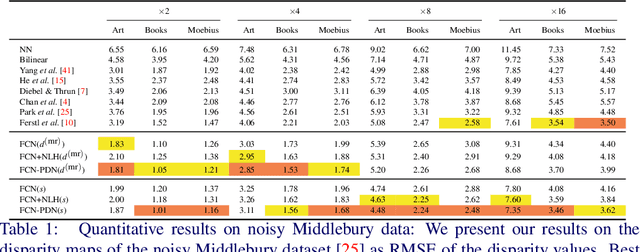Matthias Rüther
A Deep Primal-Dual Network for Guided Depth Super-Resolution
Jul 28, 2016



Abstract:In this paper we present a novel method to increase the spatial resolution of depth images. We combine a deep fully convolutional network with a non-local variational method in a deep primal-dual network. The joint network computes a noise-free, high-resolution estimate from a noisy, low-resolution input depth map. Additionally, a high-resolution intensity image is used to guide the reconstruction in the network. By unrolling the optimization steps of a first-order primal-dual algorithm and formulating it as a network, we can train our joint method end-to-end. This not only enables us to learn the weights of the fully convolutional network, but also to optimize all parameters of the variational method and its optimization procedure. The training of such a deep network requires a large dataset for supervision. Therefore, we generate high-quality depth maps and corresponding color images with a physically based renderer. In an exhaustive evaluation we show that our method outperforms the state-of-the-art on multiple benchmarks.
ATGV-Net: Accurate Depth Super-Resolution
Jul 27, 2016



Abstract:In this work we present a novel approach for single depth map super-resolution. Modern consumer depth sensors, especially Time-of-Flight sensors, produce dense depth measurements, but are affected by noise and have a low lateral resolution. We propose a method that combines the benefits of recent advances in machine learning based single image super-resolution, i.e. deep convolutional networks, with a variational method to recover accurate high-resolution depth maps. In particular, we integrate a variational method that models the piecewise affine structures apparent in depth data via an anisotropic total generalized variation regularization term on top of a deep network. We call our method ATGV-Net and train it end-to-end by unrolling the optimization procedure of the variational method. To train deep networks, a large corpus of training data with accurate ground-truth is required. We demonstrate that it is feasible to train our method solely on synthetic data that we generate in large quantities for this task. Our evaluations show that we achieve state-of-the-art results on three different benchmarks, as well as on a challenging Time-of-Flight dataset, all without utilizing an additional intensity image as guidance.
 Add to Chrome
Add to Chrome Add to Firefox
Add to Firefox Add to Edge
Add to Edge